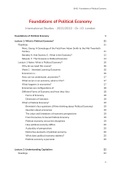Summary
Summary Political Economy COMPLETE Notes - GRADE: 8,4
- Course
- Institution
This is the complete summary of the Foundations of Political Economy Course by London - Reading, Lecture Notes + Additional Comments. The reading notes are thorough, but still concise and to the point. 175 pages in total. My final grade was a 8,4; so, studying with this should bring you far! Please...
[Show more]



